With so much choice decisions can be difficult
Kitchen sinks are available in a vast range of styles, and the construction materials offer a range of choices too. Stainless steel is still a popular option and in practical terms has a lot to commend it, but there are quartz and composite varieties which offer colour variations, fireclay or porcelain sinks which can be traditional like a Belfast, or contemporary and moulded styles in materials like Corian. Each has its own particular charm and your choice will likely be based on style of kitchen design and aesthetics, but cost can be a major factor too.
Taps (or faucets) offer an extensive range of choices too, both in terms of style and also material and colour. You can have a regular hot and cold set up or even a tap which provides instant boiling water or possible also filtered drinking water. There are choices of two taps, single mixer style, pull out spouts, single lever controls, twin handle controls, the list goes on and on.
Kitchen Sinks
Materials
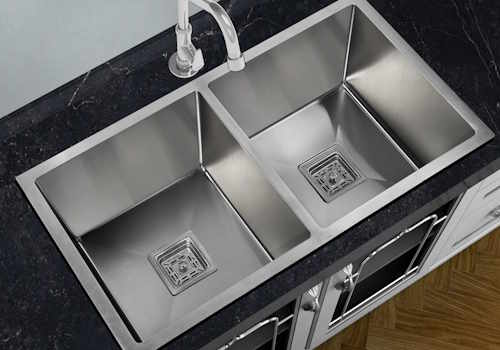
Stainless steel sinks
Stainless steel is a popular choice and offers good looks, strength and longevity.
Stainless steel is resistant to staining and chemicals and also fairly tolerant of heat. Steel sinks are easy to clean, hygienic and will retain their looks for many years.
Available in all styles and sizes steel sinks are versatile and if you are working with a limited budget will usually offer a good range of affordable options. While many of the budget price options are excellent, there are differing qualities available, and the higher priced options usually offer more design choices.
Steel is produced in varying grades, and the manufacturers choice of steel will effect the overall quality and strength of the sink. For example, an accident with something sharp or heavy might result in a crack or hole in a cheaper sink but might just a scratch in a more expensive model, due to the thickness and quality of the steel. It can be difficult to judge from simply looking, but sometimes a push down on the drainer can tell you lots. A quality sink will show very little movement whereas a sink made from thinner steel will flex noticeably.
The bowl depth in particular will vary according to how the sink has been made. Steel sinks can be made by pressing the shape out of a sheet of material, or can be made by shaping the top and bowl(s) separately, then welding the parts together. A single pressed out type will result in a shallower bowl with typically a more rounded shape while fabricating separate parts allows for deeper bowls and more flexibility with shape.
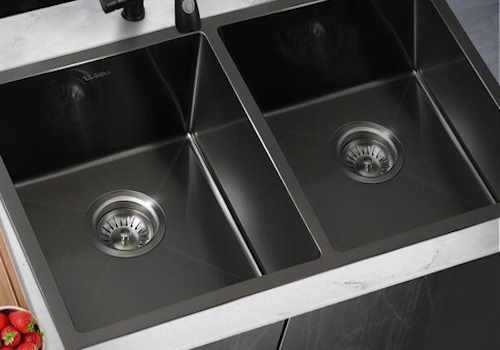
Coloured Sinks
Coloured sinks are mostly made from a composite material, usually a blend of powered stone and a plastic or resin. Most manufacturers have their own names brand names for their sink materials but they are mostly similar, using different blends and ratios of stone to resin and various polymers for the resin base. Each manufacturer will have detailed information of their particular material.
As a rule, most modern coloured sinks will be resistant to common chemicals used in kitchen cleaning, will be resistant to chipping and scratches but not suitable for taking hot pots and pans straight from the cooker.
There is a wide range of colours and styles available, so if you like the coloured option there will be a sink offering the combination of bowls and drainers that you want. The composite materials offer a rigid construction and the moulding production process means that a wide variety of shapes can be achieved.

Ceramic sinks
The typical ceramic sink will be in the Belfast, Butler or London style, variations on the image above, however other styles are available.
Ceramic offers a smooth, cool to the touch and good looking surface which is easy to keep clean and resistant to most household chemicals. Like the composite sinks, hot pans straight from the hop must be avoided; although the ceramic material has been fired at high temperature the glaze on the surface can crack if exposed to rapid temperature changes.
Ceramic is liable to chip or crack if struck by something sharp or heavy, so care is required with this sink style. The range of shapes in limited and the colour tends to be white. Colour can be achieved but most manufacturers stick to white. The manufacturing process makes it difficult to achieve sharp defined edges, so rounded rims and shapes are the norm.
The ceramic sink tends to be suited to certain kitchen styles where a traditional or rural flavour is the objective.
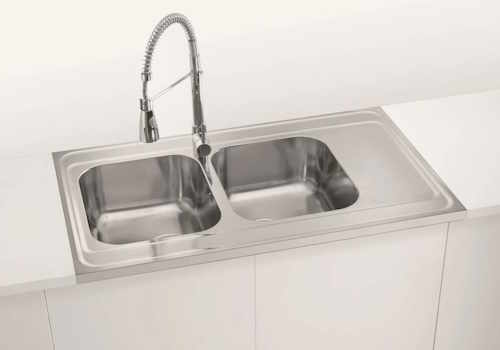
Styles
Set-on sinks
Sometime called "lay on" this sink design is fastened directly on top of the kitchen base unit and is almost invariably manufactured from stainless steel. The worktops butt up to the sink edges on either side, or on one side only if the kitchen design requires. The set on sink and base could even be fitted as a completely independent unit.
This style of sink is usually found at the budget or utility end of the market, it doesn't score many points for being pretty but it is quite a practical design, The image above shows a more stylish model, so the set on can actually look OK, but the better looks come with a higher price tag.
Set on sinks are most common in commercial kitchens and are often mounted on a steel frame or legs rather than a cupboard in a professional environment.

Inset sinks
The inset sink is designed to be fitted onto a flat surface which has been cut out to accommodate it. It can be fitted into any type of kitchen worksurface, the only requirement is a hole cut out to the required size. The sink will have a rubber strip stuck on around the underside of its rim to give a watertight seal against the worktop, and will be secured in place by clips which screw tightly underneath, clamping the sink rim tight to the worktop.
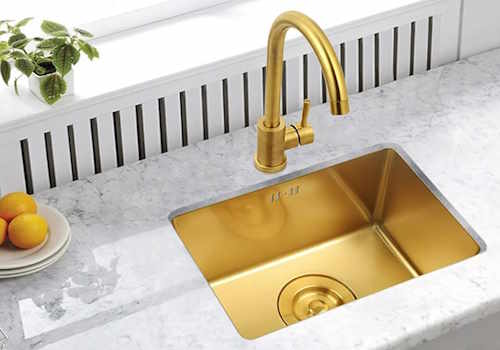
Undermount sinks
An undermount sink design, sometimes called underpinned, is designed to attach underneath the worktop. A hole is cut in the surface to the required size and the sink is secured below with a strong glue and several clip fixings. Sometimes they are fitted with the adhesive only, but a bit of extra stability from the clips is a good idea.
Because the core of the worktop is exposed when the sink is in place, this style is not suitable for laminate worktops or any with a blockboard or chipboard core as these cannot easily be waterproofed and finished neatly around the cut out. Generally this sink design is installed in a stone or solid surface material type countertop.
Kitchen Taps

Pillar taps
This is the name given to the basic tap style of two separate taps, one hot and one cold.
The taps themselves are available in different styles from very traditional looking designs to simple functional taps and can be deck mounted, stood on the sink top or worksurface, or wall mounted.
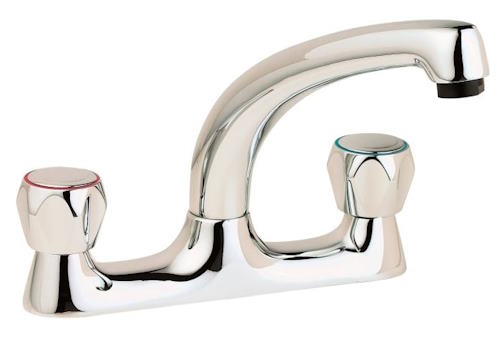
Deck mixer taps
A mixer tap of this style has one solid body fitted on the sink top or worksurface, with a swivling central spout and hot and cold controls either side. The flow from the hot and cold controls is mixed so that warm water can be provided rather than full hot or full cold. I the kitchen, where cold water needs to be potable ( fit for drinking) all mixers use a dual flow spout where hot and cold only are mixed as they leave the spout, ensuring that there is no chance for the hot water to backflow into the cold system. To be frank, the cold pressure will often be enough to prevent backflow, but water regulations in many countries require a dual flow spout.

Bridge mixer taps
The principal of the bridge mixer is the same as above, but the body of the tap is raised up off the sink top or worksurface. These tend to be used in designs where a traditional or country feel is required. They look like two pillar taps joined by a wide pipe with the spout in the centre. Again the spout will normally swivel side to side and should be dual flow.

Monoblock mixer taps / Single lever taps
The monoblock has a single tap body with a spout and in most kitchen models, the water flow is controlled by a lever at the top. The lever turns to left and right to adjust the water temperature and moves up and down to adjust flow. The spout is usually mounted on a swivel mechanism which allows the spout to rotate left and right.
As with the other mixer styles the spout should be dual flow.
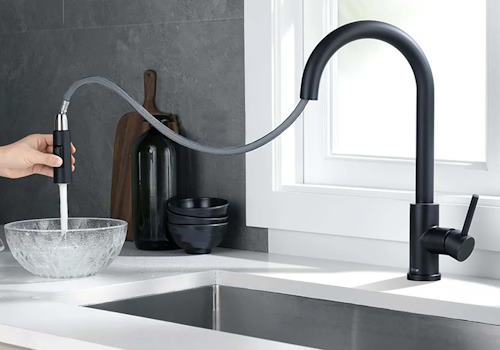
Pull out spouts
Most often found on certain lever style mixers, these feature a removable nozzle at the end of the spout which remains attached by a flexible hose. This allows for directing the water jet more precisely within the sink bowl and can be useful for cleaning around the sink, washing utensils and giving vegetables a good wash. it is definitely a handy feature but will only work well with a high pressure water supply.
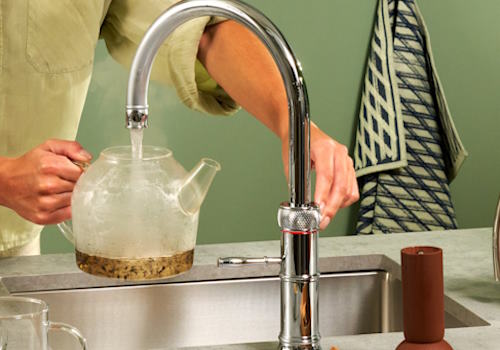
Boiling water taps
As the name suggests these devices will provide boiling, or near boiling water.
They employ a heated storage tank, usually located in or below (behind the kick board) the cupboard below. Most supply water close to 100 degrees, but there are a few which claim to deliver water at 100 degrees, said to be the required temperature to brew tea properly!
Boiling water is achieved by storing the heated water in the tank under pressure, thus boiling point can be achieved with the water remaining liquid.
If you are selecting this type of tap look out for the safety features such as child locks and cool touch spouts. Care is required with a tap which can deliver water at this temperature, so do take steps to avoid scalding. To be fair the manufacturers have safety as a number one concern, but do please check for yourself.
Many of these boiling water taps can also deliver filtered water and some even chilled and sparkling water! However there is a fairly hefty price tag for one with all the features, but it will definitely be a very useful feature in your kitchen, and could long term save on electricity, being much more efficient than a kettle or your hob.


